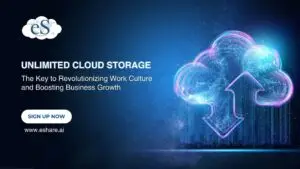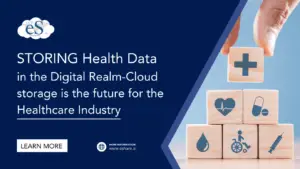Cloud computing is changing faster than we ever imagined, offering businesses access to powerful computing resources without hefty hardware investments. Future trends like multi-cloud and hybrid cloud strategies, serverless computing, and edge computing are reshaping the industry, promising enhanced performance and efficiency.
Hybrid cloud solutions blend public and private clouds for scalability and security, while serverless computing streamlines application development. Cloud-edge computing minimizes latency and optimizes bandwidth, revolutionizing industries like finance, healthcare, and manufacturing.
We discuss about trends and forecasts for cloud computing’s future in this blog. To evaluate the potential future trends of cloud computing, let’s take a closer look at the future growth in this field.


Gowtham Chand M
Content Writer
The History of Cloud Computing:
In a short period of time, the cloud computing network has advanced significantly. It was only a few short years ago that the concept of cloud computing was first introduced, and it has already transformed how businesses operate.
With cloud computing, businesses can now access powerful computer resources without having to invest in their own hardware. This has given them a major competitive advantage, as they can scale up their operations quickly and easily without having to make a large upfront investment.
Here are important future trends reshaping the cloud computing industry and propelling businesses toward unparalleled efficiency and innovation.
Key Cloud Computing Trends and Predictions 2025–2030:
- Multi-cloud and Hybrid Cloud: Enterprises are implementing multicloud and hybrid cloud strategies to optimize performance, reduce vendor lock-in, and improve cloud resiliency.
- Serverless Computing: A paradigm shift to serverless cloud computing technology increases agility, scalability, and cost efficiency, allowing developers to focus on innovation instead of infrastructure management.
- Edge Computing: The rise of cloud edge computing minimizes latency, optimizes bandwidth, and enables real-time processing, setting the stage for rapid growth in IoT and an improved user experience.
Improved cloud security: Secure multi-cloud and hybrid environments.
Multi-Cloud Technology:
A multi-cloud environment involves the use of services and resources from multiple cloud providers. This can include a combination of public cloud, private cloud, and even on-premises infrastructure.
The appeal of a multi-cloud strategy lies in its potential to reduce vendor lock-in, optimize costs, and improve application performance by placing the workloads that best meet your needs in the cloud.
Strategies for a Secure Multi-cloud Environment Centralized
Identity and Access Management (IAM): Consistent access restrictions and a lower risk of unauthorized access are ensured by using a single IAM system across all clouds. It will be cut down.
- Data Encryption: Protect sensitive information from unauthorized access by encrypting data at rest and in transit in all cloud environments.
- Consistent security policies: Establishing and enforcing consistent security policies across all cloud platforms ensures consistent levels of protection and compliance.
- Threat Monitoring and Incident Response: Deploying robust threat detection tools and a well-defined incident response plan across all clouds improves an organization’s ability to quickly detect and mitigate security breaches.
- Working with a Cloud Solution Provider: Effective security in a multi-cloud environment requires working with a cloud technology solution provider.
Enterprise cloud solutions often offer security tools and services that help you keep the overall protection of your multi-cloud ecosystem at its best. When pursuing multi-cloud security, organizations must strike a balance between protecting assets and enabling innovation. The future of cloud computing will unfold through the interplay of security, innovation, and multi-cloud strategies.
Adopting Hybrid Cloud Technology:
In the future of cloud computing, businesses are increasingly turning to hybrid cloud solutions – a strategic mix of public and private clouds. This innovative approach leverages the strengths of both models to create a flexible, efficient, and secure computing environment.
Hybrid Cloud Benefits:
A hybrid cloud offers many benefits tailored to different business needs.
- Scalability: Companies can scale up or down resources as needed. While public clouds offer rapid scalability, private cloud integration ensures that your critical data and sensitive workloads are protected.
- Flexibility: Organizations can choose where to deploy workloads based on their needs. Non-sensitive tasks can take advantage of the power of the public cloud, while business-critical operations can be performed in a private domain.
- Improved data security: The hybrid cloud increases security by separating data and applications.
- Cost Efficiency: Hybrid architectures optimize costs by leveraging low-cost public cloud resources for non-sensitive operations, reducing the need for excessive infrastructure investments.
- Compliance: Industries with strict regulatory requirements, such as finance and healthcare, can benefit from a hybrid cloud.
Industry-wide traction:
Hybrid cloud solutions are making great strides in a variety of areas.
- Finance: Banks are adopting hybrid clouds to segregate customer data while leveraging public clouds for customer-facing applications.
- Healthcare: Healthcare facilities securely store patient records in a private cloud and use the public cloud for less sensitive tasks, such as administrative functions. This allows healthcare providers to balance compliance requirements while optimizing costs.
- Games: Game developers use hybrid clouds to handle heavy computing tasks such as graphics rendering and combine public cloud resources with private servers to enable real-time interactions. Supports flexible deployment options for gaming and the broader software industry.
- Manufacturing: A hybrid cloud allows manufacturers to monitor production processes using IoT devices while protecting intellectual property in a private cloud. Overall, it helps support supply chain management through flexibility and scalability.
Serverless Computing:
In this model, the developer focuses only on writing the code, and the cloud solution provider is responsible for deploying, expanding, and maintaining the servers.
Benefits of Serverless Computing: Serverless architecture offers a variety of benefits.
- Improved scalability: Serverless platforms automatically scale resources as needed. This pay-as-you-go approach allows applications to handle a variety of workloads without manual intervention.
- Cost Efficiency: Businesses only pay for the computing resources actually used during execution. This eliminates the need for ongoing provisioning and maintenance of resources, reducing costs.
- Simplified deployment: Developers can focus on coding instead of managing servers, resulting in faster deployment and faster time-to-market for applications.
- Autoscaling: Serverless platforms automatically scale to ensure optimal performance during peak loads without manual intervention.
Industry Momentum
Finance: It can provide real-time, automated customer care through the use of serverless chatbots and virtual help. Furthermore, it can support the operation of financial applications like fraud detection and real-time payment processing.
Healthcare: Automatically identifying abnormalities in medical pictures, such as MRIs and X-rays, to help medical practitioners diagnose patients. In addition, it may support telemedicine services, remote monitoring, and virtual doctor-patient consultations, offering an affordable healthcare option.
The Rise of Cloud Edge Computing
There is no denying that this cloud computing movement is revolutionary. Cloud edge computing, which is frequently used at the “edge” of the network, puts computation closer to the data source than typical cloud architecture, which centralizes data processing and storage in far-off data centers.
This close proximity lowers latency, improves real-time processing capabilities, and resolves bandwidth-related issues.
Management of Latency and Bandwidth Issues:
For applications like Internet of Things devices, driverless cars, and remote healthcare solutions that demand instantaneous reactions, latency—the time interval between transmitting and receiving data—is a crucial problem. By processing data locally, one may minimize the amount of information that needs to be sent to and from faraway data centers, therefore reducing latency. The nearby placement of cloud-edge servers or gateways enables this quick processing.
The use of bandwidth presents another difficulty. Network resources may be strained when massive amounts of data are sent to central servers. Edge computing maximizes the use of available bandwidth by processing information locally and only transmitting necessary data to the cloud.
The benefits of edge computing are demonstrated in several fields:
- Finance: The Cloud Edge app helps with fraud detection and real-time risk analysis. At the edge, transaction processing and data analysis provide faster reaction times to possible threats.
- Healthcare: By processing vital signs locally, wearable health gadgets shorten reaction times and provide instant notifications for urgent situations.
- Manufacturing: By evaluating sensor data from the manufacturing equipment, real-time quality controls on production data and predictive maintenance are made possible.
In conclusion, it’s critical to comprehend these advancements and actively participate in influencing them if you want to stay ahead of the competition. When addressing business and consumer expectations, organizations that accomplish this will improve scalability, be more cost-effective, and be more competitive.
Embrace transformation and integrate these cloud computing trends into your enterprise strategy. The evolving landscape rewards those who adapt and stay secure.








